Bordeaux De-Mystified
Notes From the World’s Greatest Wine Region

I have long been a wine aficionado. I started appreciating fine wine when I lived in Washington D.C. in the Eighties. Back then, D.C. liquor stores could import wines directly and you could buy great wines for a small fraction of what you would pay today. Thus, I was fortunate to cut my teeth on some of the world’s best bottles.
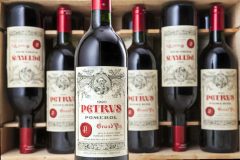
Back then, California wines were just starting to gain market traction, so I found myself gravitating toward French Bordeaux wines. Bordeaux wines have power and finesse that put them among the very best on the planet. Unfortunately, they can be somewhat confusing to the average American wine drinker. While you won’t be a Bordeaux expert after reading this, you will hopefully find it easier to navigate the complexities of the style and gain perspective on Bordeaux relative to similar styles like California Cabernets, Merlots and other varietals.
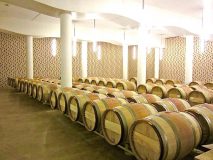
Barrels aging at Chateau Cheval Blanc
Bordeaux Basics
Let’s start with geography. Bordeaux is a region in Southwestern France, not far from the Atlantic Ocean. It is a wine-growing region and the city of Bordeaux is in that region as well. Bordeaux consists of several sub-regions divided by the Gironde River. While there are quite a few of these, we will focus on the most significant ones. On the western side of the Gironde (the “Left Bank”) are the Medoc, Haut-Medoc and Graves sub-regions. On the eastern side (the “Right Bank”) are the sub-regions of Saint Emilion and Pomerol.
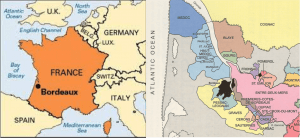
The Left Bank wines are further defined by appellations or AOCs (appellation d’origine contrôlée). These are based on terroir – common environmental factors that contribute to the overall character of the wines. The AOC system presumes that the land where grapes are grown imparts unique qualities that are specific to that growing area. AOCs on the Left Bank include the Medoc, Haut-Medoc, Saint-Estephe, Pauillac, Saint-Julian, and Margaux. South of the Medoc, the Graves sub-region produces both red and white wines and the Sauternes sub-region is known for golden, sweet dessert wines.
The important point to remember with Bordeaux wines is that they are categorized by geography. By contrast, California, Australia, South Africa and South America categorize their wines by grape varieties (such as Cabernet Sauvignon, Merlot and Chardonnay).
Classified Growths
Unlike most wine regions, Bordeaux tells us which wines are the best based on quality. The Official Classification of 1855, which is still in use today, essentially rank-ordered the best Bordeaux wines into five classes:
First Growths – Premier Cru
Second Growths – Deuxiemes Cru
Third Growths – Troisiemes Cru
Fourth Growths – Quatriemes Cru
Fifth Growths – Cincuiemes Cru
These 61 Chateau represent the very finest Bordeaux wines. For smaller producers, between 240 and 260 lesser (but still good) wine estates are classified Cru Bourgeois. The regions of Graves and Saint Emilion were classified separately in 1953 and 1954 respectively. To see the full 1855 Classification, click here!
The term Cru refers to a growth or wine, or a vineyard or group of vineyards. A Chateau is a castle or great house, which generally includes the winemaking facilities.
How do you spot a Bordeaux on a retail shelf? The shape of the bottle differentiates Bordeaux from Burgundy. The Bordeaux bottle is more straight-sided with a straight neck and a compact shoulder. Burgundy bottle have a more gentle and elongated shoulder.
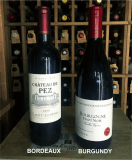
It’s interesting to note that California, Australia and other wine-growing regions tend to follow Bordeaux’s lead – packaging Bordeaux grape varieties in Bordeaux-style bottles and Burgundy grape varieties in Burgundy-style bottles.
Reading a Bordeaux Label
Compared to Burgundy and some other wine regions, Bordeaux labels are not hard to interpret, but you need to know some basics.
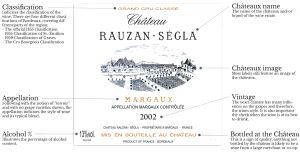
The most important information on the label is the Chateau name, the appellation and the vintage.
Vintages are important because the quality of the wine is directly linked to weather, environmental factors, and harvest conditions. While individual estates (Chateau) might produce good wines in an off-vintage, many do not. When shopping for wines, it’s a good idea to consult a good vintage chart and, if possible, reviews of a particular wine you are considering buying.
Bordeaux Grape Varieties
While Bordeaux wines are defined by the appellations rather than grape varieties, grapes are nonetheless significant. The are five grape varieties used in making Bordeaux wines – Cabernet Sauvignon, Cabernet Franc, Merlot, and to a lesser extent Petit Verdot and Malbec. Almost all Bordeaux are blends of the first three.
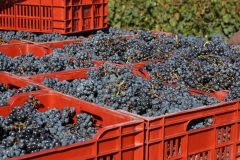
For Left Bank wines, Cabernet Sauvignon dominates the blend. A typical top-quality Medoc blend would be 70% Cabernet Sauvignon,15% Merlot, and 15% Cabernet Franc. On the Right Bank, Merlot is the dominant grape in Pomerol and Saint Emilion blends, with Cabernet Franc and Cabernet Sauvignon playing supporting roles. Typical Right Bank blends are 60% to 80% Merlot with lesser quantities of Cabernet Franc and Cabernet Sauvignon.
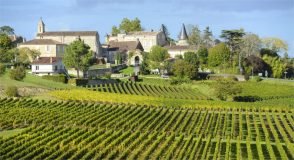
In California, a grape variety must be at least 75% of the blend to bear the name of that variety. If a California vineyard is trying to make a Bordeaux style blend, of say 60% Cabernet Sauvignon, 25% Merlot and 15% Cabernet Franc, it does not have a sufficient percentage of Cab to be called a Cabernet Sauvignon. So, these wines are referred to as Meritage wines rather than as specific varietals.
The First Growth Wines of Bordeaux
If you are looking to taste the very best, Bordeaux’s First Growth (Premier Cru) wines are arguably the best wines on the planet. Don’t expect that taste to come cheaply, though. Because of limited supply, their collectability and high demand globally, these wines are expensive . . . ridiculously so. For example, the 2016 Chateau Lafite Rothschild is currently selling for about $657.00 a bottle, and this will increase over time. Also, keep in mind that this wine will not be ready to drink for at least ten years, maybe more. The current price for a 2010 Lafite is around $1,141.00.

Chateau Haut Brion in Graves
If you do decide to splurge (maybe with some friends chipping in) make sure you choose a wine from a good year (check your vintage chart), that is at least 10-15 years old and that you know has been kept under ideal conditions (temperature-controlled wine cellar). The age is important since this caliber of wine is quite tannic. The tannins preserve the wine over the long haul, but can be hard and astringent in their youth. Over time, the tannins break down and soften, allowing the true essence of these great wines to come through.
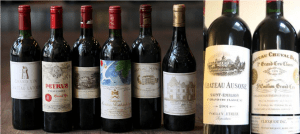
Bordeaux’s Finest Red Wines
So, which wines are among the First Growths? From the Medoc, Chateau Lafite Rothschild, Chateau Latour, Chateau Mouton Rothschild and Chateau Margaux are the First Growths. Chateau Haut Brion from Graves and Chateau Cheval Blanc and Chateau Ausone from Saint Emilion are also included as First Growths. And from Pomerol, the priciest and often the best, First Growth is Chateau Petrus.
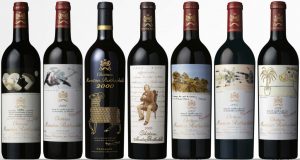
Chateau Mouton’s Art Labels
An interesting note on one of these wines – Chateau Mouton Rothschild – is that Mouton has a different renowned artist featured on the label each year. This started in 1945 and continues to this day. Mouton pays the artists with cases of wine. Some of the world’s greatest artists have appeared on Mouton labels, including Picasso, Chagall, Dali, Miro, Motherwell, Warhol, and a raft of others.
Bordeaux Second Growth Wines
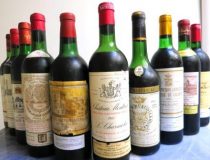
For Quality and Value Second Growth Wines Stand Out
As enticing as the First Growth wines are, the Second Growths offer comparable quality in many cases at a fraction of the price. For instance, compared to the Chateau Lafite Rothschild with its $657.00 price tag, you can pick up the excellent Chateau Cos d’Estournel or Chateau Pichon Lalande for around $162.00. Still not cheap, but a quarter of the First Growth price tag. Other Second Growths can be had for as little as $60.00 to $80.00.
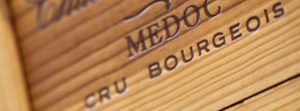
The Best Bargains in Bordeaux
There are also better deals on Third, Fourth and Fifth Growth Bordeaux. And, the best deals for less-than-special occasions are the Cru Bourgeois wines. With around 250 wine estates amounting to 40% of all Bordeaux production, there are many bargains to be found in this group.
The Amazing Dessert Wines of Sauternes and Barsac
A discussion of Bordeaux would not be complete without looking at the fine sweet dessert wines of Sauternes and Barsac. The Graves region produces both red and white wines. White Bordeaux – made from Semillon, Sauvignon Blanc and Muscadelle grapes – are light, dry and grassy, and good choices with a range of dishes.
Sweet Sauternes and Barsac wines are late-harvest wines. To make these, grapes are left on the vine past the normal harvest. These grapes become infested with botrytis cinerea or “noble rot,” a fungus that shrivels up the grapes, concentrating the fruit sugars and yielding a very sweet and luscious wine.
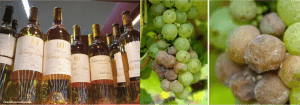
Sauternes wines and Botrytis-infected Grapes
The Premier Cru Superieur (best) Sauternes is Chateau d’Yquem (pronounced Shato de Kem) and it is a truly monumental wine. While there are many delicious Sauternes, Chateau d’Yquem is in a class by itself. I have had the good fortune to taste this amazing wine on several occasions and remember it as “the nectar of the Gods.” If you have a wine bucket list, this wine should be on it (oh, and start saving up now).
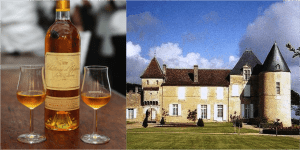
Chateau d’Yquem – the Legendary Dessert Wine
The World’s Greatest Wine Region
Combine spectacular French countryside with picturesque chateau and manicured vineyards and you have a geography of stunning beauty. Add brilliant wines made with centuries of wine-making experience and you have Bordeaux – the world’s greatest wine region.
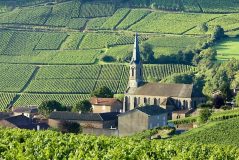
Whether you go for classified growths or less complicated Cru Bourgeois, Bordeaux offers you a world of wines with power, subtlety and finesse unlike any region on the planet




Leave a Reply